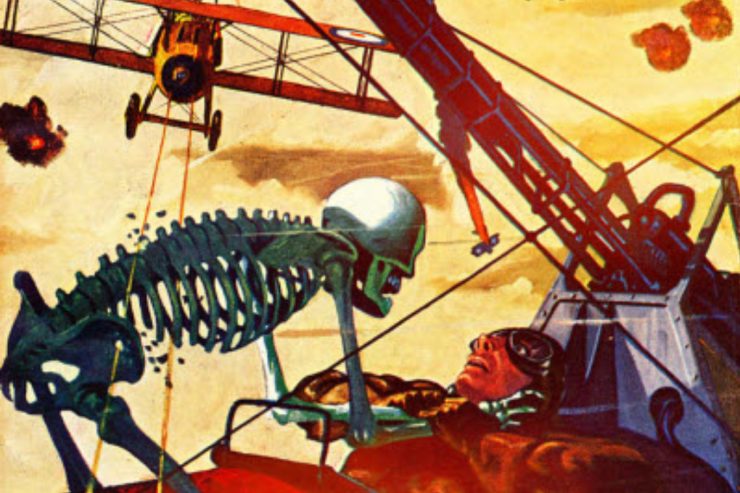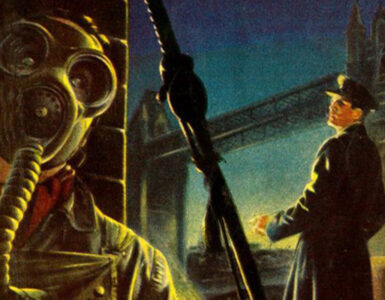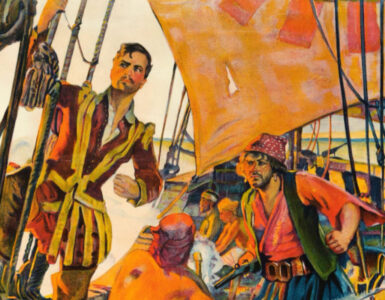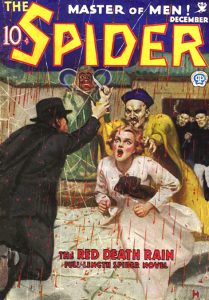 In the vintage pulp era, most marketing directors didn’t seem too interested in the concept of seasonal or holiday themes for their various magazine titles. This holds particularly true with the great hero pulps.
In the vintage pulp era, most marketing directors didn’t seem too interested in the concept of seasonal or holiday themes for their various magazine titles. This holds particularly true with the great hero pulps.
You won’t find any Green Lama Christmas stories or Domino Lady St. Patrick’s Day thrillers.
That said, you can make the argument that any hero pulp that was worth its salt celebrated or at least suggested Halloween at some time or other. This was particularly true with the great Popular Publications pulp heroes — The Spider, G-8 and His Battle Aces, and Operator #5.
Norvel Page and his fellow “Grant Stockbridges” festooned The Spider’s bibliography with its share of “devils,” “dragons,” “vampires,” “terrors,” “monster men,” and “corpse brigades.” And we haven’t even mentioned the visits from “Satan” and “Death,” nor the numerous trips to “Hell.”
While the more subdued Street & Smith heroes such as Doc Savage and The Shadow tended to be more teasers than traffickers in true supernatural terror, The Spider wore a fright wig, false fangs, and a fake hump on his back, essentially presenting himself as a sort of silent-film era embodiment of a film monster.
Logic, tight plotting, and The Spider were rarely acquainted, and with a death count in some single Spider novels arguably eclipsing that in the whole of the original 181 Doc Savage pulp run, The Spider often waded deeper into true monster territory than many of his hero pulp brethren.
The terrors start with Norvell Page’s first Spider adventure, “Wings of the Black Death,” published in the December 1933 issue of Popular Publications’ The Spider. Employing infected pigeons, Page’s villain unleashes the bubonic plague upon the population of New York City. Three issues later, the Food Destroyers plot to wipe out the U. S. food supply in “The Citadel of Hell.” Next, The Red Mandarin poisons all the tobacco, liquor, and coffee, turning consumers into addicted slaves in “The Red Death Rain.”
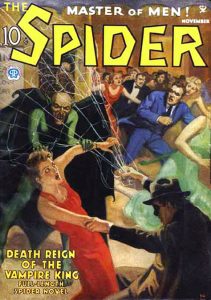 In “Death Reign of the Vampire King,” The Bat Man terrorizes the country with hordes of poisoned bats, while “The Cholera King” infects a city without medicine and hordes of madmen overrun New York in “Legions of Madness.” And that’s just in the magazine’s first three years! Still to come are “When Thousands Slept in Hell,” “The Spider and the Slaves of Hell,” ” Master of the Night-Demons,” “The Spider and the Sons of Satan,” and the series’ final story, “When Satan Came to Town.”
In “Death Reign of the Vampire King,” The Bat Man terrorizes the country with hordes of poisoned bats, while “The Cholera King” infects a city without medicine and hordes of madmen overrun New York in “Legions of Madness.” And that’s just in the magazine’s first three years! Still to come are “When Thousands Slept in Hell,” “The Spider and the Slaves of Hell,” ” Master of the Night-Demons,” “The Spider and the Sons of Satan,” and the series’ final story, “When Satan Came to Town.”
The Spider ran for 118 issues, ending with its December 1943 number. The series was written by R. T. M. Scott, Norvell Page, Emile C. Tepperman, Wayne Rogers, and Prentice Winchell, who wrote the final published story.
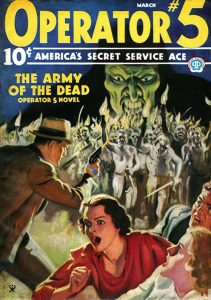 Frederick C. Davis, Emile C. Tepperman, and Wayne Rogers were the creators of the American dystopias described in the adventures of America’s Secret Service Ace, “Operator 5.” Soulless stormtroopers carry out a sinister madman’s plot in Davis’ “The Army of the Dead,” while a religious cult sweeps across America in his “Invasion of the Crimson Death Cult.” In Emile Tepperman’s “The Siege That Brought the Black Death,” the plague sweeps across America and day turns to darkest night in Wayne Rogers’ “Corpse Cavalry of the Yellow Vulture.” The series debuted in early 1934 and ran for 48 issues, ending in 1939. It was the publisher’s response to events of a world nearing the brink of war.
Frederick C. Davis, Emile C. Tepperman, and Wayne Rogers were the creators of the American dystopias described in the adventures of America’s Secret Service Ace, “Operator 5.” Soulless stormtroopers carry out a sinister madman’s plot in Davis’ “The Army of the Dead,” while a religious cult sweeps across America in his “Invasion of the Crimson Death Cult.” In Emile Tepperman’s “The Siege That Brought the Black Death,” the plague sweeps across America and day turns to darkest night in Wayne Rogers’ “Corpse Cavalry of the Yellow Vulture.” The series debuted in early 1934 and ran for 48 issues, ending in 1939. It was the publisher’s response to events of a world nearing the brink of war.
But in terms of truly swinging for the supernatural fences, the World War I flying ace and master spy, G-8, seemed to be ranged against more apparently “real” monsters than any other pulp hero of the 1930s.
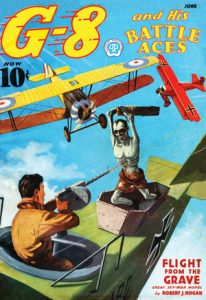 In his 110 adventures — all written by Robert J. Hogan — G-8 heedlessly skidded into the occult, well beyond the boundaries of most of his already envelope-pushing contemporaries. Envisioned as an air war version modeled upon the success of Doc Savage and The Shadow, Hogan determined to avoid redundancy and monotony by injecting a healthy dose of fantasy into the adventures of “the verdammt one” . . .
In his 110 adventures — all written by Robert J. Hogan — G-8 heedlessly skidded into the occult, well beyond the boundaries of most of his already envelope-pushing contemporaries. Envisioned as an air war version modeled upon the success of Doc Savage and The Shadow, Hogan determined to avoid redundancy and monotony by injecting a healthy dose of fantasy into the adventures of “the verdammt one” . . .
Dead German aces rise from the grave in “Squadron of Corpses.” A legion of headless German soldiers controlled by a hunchback destroys everything in its path in “The Headless Staffel.” Amed Ghezi transplants the brains of wolves into the bodies of men in “Curse of the Sky Wolves.” King Jolito, a Haitian voodoo doctor, summons forth zombies in “Flight from the Grave.” The Mother of Vampires raises an undead horde in “The Bloody Wings of the Vampire.” And the mad surgeon, Herr Doktor Runtz, turns men into beasts in “The Flying Coffins of the Damned,” one of many fantastic examples found in Hogan’s novels written for G-8 and His Battle Aces.
With the arrival of Halloween, may we recommend a trip to The Big Apple to meet “The Mayor of Hell,” or Washington, DC to experience the “Blood Reign of the Dictator,” or No Man’s Land for an encounter with “The Patrol of the Dead?”
We look forward to seeing you next year at PulpFest 2023 and our celebration of the 90th anniversary of Popular Publications’ nightmare heroes and other great pulp heroes of 1933. The convention is scheduled for August 3 – 6, at the DoubleTree by Hilton Hotel Pittsburgh – Cranberry in Mars, Pennsylvania.
Bookmark pulpfest.com to stay informed! Follow us on Facebook, Twitter, and Instagram. And don’t forget to subscribe to our YouTube Channel and our e-letter.
Popular Publications unleashed their first three hero pulps during 1933 – 34. G-8 and His Battle Aces and The Spider both debuted with their October 1933 issues. Operator #5 would debut half a year later with its April 1934 number.
For more on G-8 and The Spider, please visit our YouTube Channel to view “90 Years of the Great Pulp Heroes #4” — G-8 and His Battle Aces and “90 Years of the Great Pulp Heroes #5” — The Spider — both created by PulpFest‘s Craig McDonald.
While Frederick Blakeslee would paint the covers to all 110 issues of G-8 — including the June 1937 number, featuring Robert J. Hogan’s “Flight from the Grave” and the October 1941 issue, featuring Hogan’s “Squadron of the Flying Dead” — John Newton Howitt would contribute the cover art for the entire run of Operator #5, excepting the first issue (which was painted by Jerome Rozen). Frederick C. Davis’ “The Army of the Dead” ran in the March 1935 number.
While Howitt would paint nearly four dozen covers featuring “The Master of Man,” he shared cover artist credit on the series with Walter Baumhofer (the first issue) and Rafael De Soto. To learn more about John Newton Howitt, read “The Mystery and Mastery of John Newton Howitt,” featured on our site in July 2014. Pictured above are Howitt’s covers for “The Red Death Rain,” published in the December 1934 issue of The Spider, and “Death Reign of the Vampire King,” featured in the November 1935 number.
Kenneth Grant is a writer and popular culture enthusiast who began writing for our website earlier this year. He particularly enjoys hero pulps and was more than happy to put together this look at the “Halloween Heroes” of Popular Publications. Click here to read Craig McDonald’s “A Pulp Hero’s Trick-or-Treat,” published for Halloween 2021.

